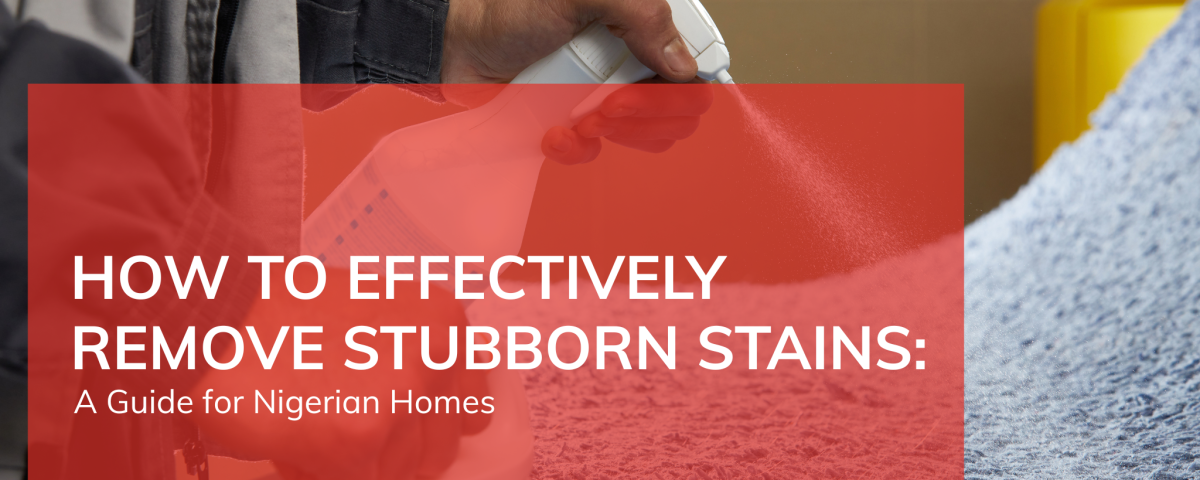
The Art of Industrial Cleaning in Nigeria: Expert Tips and Tricks
June 14, 2024
How to Clean and Maintain Bathrooms: A Complete Guide for a Fresh, Hygienic Space
March 12, 2025Stains on clothes, carpets, and furniture can be a source of frustration, especially when they seem impossible to remove. In Nigerian homes, where activities like cooking, outdoor play, and office work are part of daily life, stains such as oil, ink, and mud are all too common. If you’ve found yourself struggling to clean these stains, don’t worry! This article will provide practical and effective solutions for removing stubborn stains, making your household chores much easier.
1. How to Remove Oil Stains from Clothes and Surfaces
Oil stains can be particularly tricky to remove, as they tend to seep deep into fabric fibers. This is a common issue in Nigerian homes, where cooking oil, palm oil, or vegetable oil is frequently used in the kitchen.
Solution for Clothes
To remove oil stains from your clothes, start by blotting the stain gently with a paper towel or clean cloth to absorb excess oil. Avoid rubbing the stain, as this can push the oil deeper into the fabric.
Next, apply a small amount of dishwashing liquid directly onto the stain. Dish soap is designed to break down grease and oils. Let it sit for 10–15 minutes, then rinse with warm water. If the stain persists, apply a paste made from baking soda and water to the area and let it sit for an additional 15–20 minutes before washing it as usual.
Solution for Upholstery and Carpets
For oil stains on furniture or carpets, sprinkle cornstarch or baby powder directly on the stain. These powders will absorb the oil. Allow it to sit for about 10–15 minutes, then vacuum the area. Afterward, apply a mild dish detergent solution, blot gently, and rinse with water.
2. How to Remove Ink Stains from Clothes and Fabrics
Ink stains are a common issue, especially in households with students or working professionals. Whether it’s a spilled pen or a printer mishap, ink can leave stubborn marks on your clothing.
Solution for Clothes
To tackle ink stains, first place the stained fabric on a clean towel, and then blot the stain with rubbing alcohol or hand sanitizer. You can also use a cotton ball soaked in rubbing alcohol and gently dab it on the stain, being careful not to spread the ink further.
Allow the rubbing alcohol to sit for a few minutes before rinsing the fabric with cold water. Wash the item as you normally would with detergent. If the stain remains, repeat the process, or use a stain remover product before washing.
Solution for Upholstery and Carpets
For ink stains on upholstery or carpets, apply a solution of one part vinegar and one part water to the stained area. Dab the mixture on the ink stain using a clean cloth, then blot with a dry cloth to remove excess moisture. Repeat this process until the stain lifts. Be sure to test this solution on an inconspicuous area first to avoid damage to the fabric.
3. How to Remove Mud Stains from Clothes and Shoes
Mud stains are common, especially in Nigerian households where outdoor activities such as playing football, gardening, or walking in the rain are a regular occurrence. Mud stains, while difficult, are not impossible to clean.
Solution for Clothes
For mud stains on clothes, first allow the mud to dry completely. Trying to remove wet mud can spread the stain further. Once dry, gently scrape off any excess mud with a spoon or blunt knife.
Next, soak the item in cold water for 30 minutes to loosen any remaining dirt. After soaking, apply a stain remover or liquid laundry detergent directly to the stain and gently scrub with a soft brush. Wash the clothes in cold water, and repeat if necessary.
Solution for Shoes
Mud stains on shoes can be cleaned by first letting the mud dry and then brushing off the excess. For leather or synthetic shoes, use a damp cloth to wipe away the remaining dirt. If needed, apply a mixture of mild soap and water to remove any stubborn stains. For fabric shoes, use a soft brush to scrub with detergent before rinsing.
4. Preventing Future Stains in Your Home
Prevention is always better than cure. To help prevent stains from becoming a regular issue, consider the following tips:
- Use aprons and tablecloths: When cooking or working, use aprons to protect your clothing from oil and food stains. Tablecloths can also catch spills before they reach your furniture.
- Create a stain-free zone for kids: Set up a designated play area for children, away from delicate fabrics and furniture. Ensure that they wear protective clothing when playing outside.
- Act quickly: Stains are easier to remove when they are fresh. As soon as a stain occurs, act immediately to blot, rinse, and treat the area.
5. Conclusion
Dealing with stains in Nigerian homes is inevitable, but it doesn’t have to be stressful. With the right cleaning techniques and a little patience, you can successfully remove even the most stubborn stains like oil, ink, and mud. Keep your household fabrics looking fresh and clean by following the solutions provided above, and don’t forget to implement preventive measures to reduce future stains.
By staying proactive, you’ll spend less time scrubbing and more time enjoying your home and its surroundings. So, next time you face a tough stain, remember this guide, and tackle it head-on with confidence!


